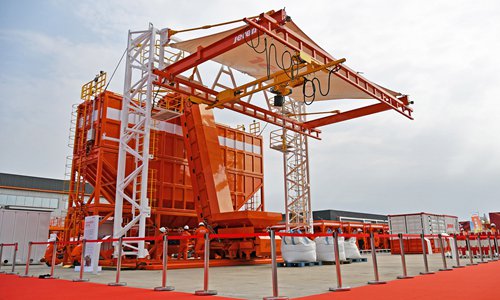HOME >> SOURCE
Market’s role decisive in China’s imports
By Song Lin Source:Global Times Published: 2020/1/19 20:53:41
Expanding purchases from US in line with consumers’ rising demand

The world's first kit equipped with electric fracking for shale gas production was achieved on Saturday by Yantai Jereh Oilfield Services Group Co based in East China's Shandong Province. The facility is expected to lower the costs for shale gas output and improve efficiency, while reducing the reliance on imports. Photo: IC
Chinese companies will negotiate with their US partners to expand imports based on market principles and WTO rules, a Chinese official said on Sunday, in responding to one of the key elements in the newly reached China-US phase one trade deal - expanding imports from the US.China and the US are highly complementary in economic and trade cooperation, Meng Wei, a spokesperson of China's National Development and Reform Commission (NDRC), said at a press conference on Sunday.
Both China and the US are market economies, and Chinese companies will consult with their counterparts from the US to expand imports, based on market principles and WTO rules, Meng told the conference.
Following WTO rules and market principles is the basic premise for trade between market economies, including China and the US, Liu Jianying, an associate research fellow at the Chinese Academy of International Trade and Economic Cooperation, told the Global Times.
According to the terms of the first phase trade deal released by the NDRC on Thursday, China's purchases and imports from the US will exceed the 2017 baseline amount by no less than $200 billion within two years - that is, by the end of 2021.
China and the US acknowledge that purchases will be made at market prices based on commercial considerations and that market conditions, particularly in the case of agricultural goods, may dictate the timing of purchases within any given year, read the trade deal.
For market economies, it is enterprises that will determine import figures based on demand and supply, Zhuang Rui, a deputy dean of the University of International Business and Economics' Institute of International Economics in Beijing, told the Global Times.
The $200 billion import "target" offers a guideline and trade outlook for the two countries in the future, Zhuang said, noting that the Chinese market objectively has the corresponding level of import demand based on experience.
Affected by the trade war, data from China's General Administration of Customs showed that trade between China and the US stood at 3.73 trillion yuan ($543.8 billion) in 2019, down 10.7 percent year-on-year.
The US-initiated trade war has hindered bilateral trade, while the trade deal paves the way for enterprises from both sides to resume or expand trade based on each country's situation, experts said.
The trade "target" figures indicate each side's relative advantages, Liu noted.
"The US has good supply capacity in energy, manufactured goods, agricultural products, medical care and financial services," Meng said.
To expand imports from the US is in line with Chinese consumers' demand for advanced goods and services, as well as the domestic economy's high-quality development, Meng noted.
China is striving to promote a high-quality development model rather than purely pursuing high-speed economic growth, with a corresponding surge in middle-income households and the breakthrough of $10,000 GDP per capita in 2019.
Against the backdrop of mounting downward pressure on the global economy and trade protectionism, China achieved steady GDP growth of 6.1 percent in 2019, according to data from the National Bureau of Statistics on Friday.
Even though both the external and internal situations remain complex, China's economic growth is resilient. With a super large market and great domestic demand potential, the long-term promising economic growth trend would not change, Meng said.
Posted in: ECONOMY